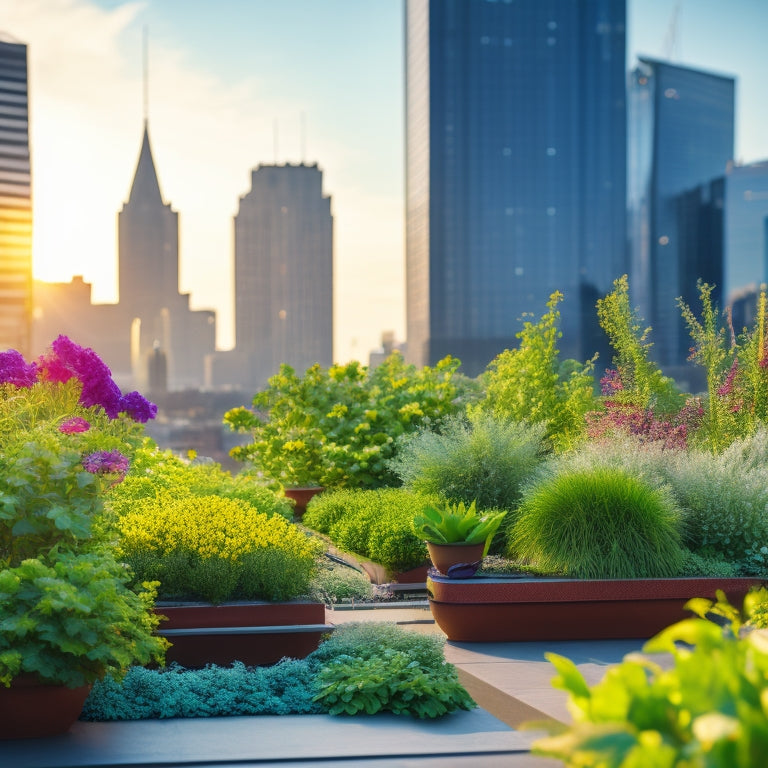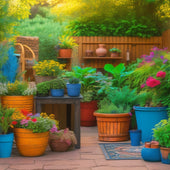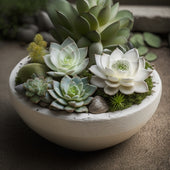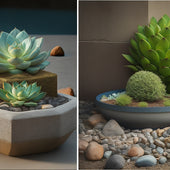
Launching a Thriving Hydroponic Rooftop Garden: What's Next?
Share
You've successfully navigated the initial planning stages of your hydroponic rooftop garden, and now it's time to focus on the vital details that will guarantee a thriving and sustainable ecosystem. Next, assess your rooftop space's structural integrity, sunlight exposure, and accessibility to water and electricity. Choose a hydroponic system that fits your space and crop needs, and select crops that thrive in controlled environments and have moderate to fast growth rates. By understanding these essential factors, you'll be well on your way to creating a flourishing hydroponic rooftop garden, and there's still more to explore to optimize your garden's potential.
Key Takeaways
• Assess rooftop space for structural integrity, sunlight exposure, and accessibility to water and electricity for a successful hydroponic setup.
• Choose a hydroponic system that suits your space, budget, and crop selection, considering factors like maintenance and environmental impact.
• Select crops that thrive in hydroponic conditions, have moderate to fast growth rates, and align with your system's capabilities and resources.
• Monitor and adjust pH levels, nutrient uptake, and temperature to create an optimal environment for healthy plant growth and development.
• Regularly inspect and maintain your hydroponic system to prevent issues, ensure efficient water use, and promote a thriving rooftop garden.
Assessing Your Rooftop Garden Space
Before designing your hydroponic rooftop garden, evaluate your rooftop space by examining its structural integrity, sunlight exposure, wind direction, and accessibility to water and electricity.
You'll want to verify your rooftop can support the weight of your hydroponic system, plants, and any additional infrastructure.
Consider the amount of sunlight your rooftop receives, as most plants require at least six hours of direct sunlight per day.
Take note of any shading from nearby buildings or trees, which may impact sunlight exposure.
Wind direction is also vital, as strong gusts can damage your plants and system.
You'll need to implement wind protection measures, such as windbreaks or sheltered areas, to mitigate this risk.
Finally, review the accessibility of your rooftop to water and electricity sources.
You'll need a reliable water supply and power source to operate your hydroponic system.
Choosing the Right Hydroponic System
With your rooftop space evaluated, you can now focus on selecting a hydroponic system that suits your specific needs and goals. There are several system types to contemplate, each with its own advantages and disadvantages. You'll need to decide between a nutrient film technique (NFT) system, ebb and flow system, drip irrigation system, or aeroponic system, among others. Reflect on factors such as space constraints, water usage, and crop selection when making your decision.
It's vital to assess the system maintenance requirements of each option. Some systems require daily monitoring, while others can be automated. Think about your availability and willingness to perform routine maintenance tasks, such as cleaning pumps and checking pH levels.
Additionally, ponder the initial investment and ongoing costs associated with each system. By carefully weighing these factors, you can choose a hydroponic system that meets your needs and guarantees a thriving rooftop garden. A well-maintained system will promote healthy plant growth, reduce waste, and minimize environmental impact.
Selecting the Best Crops for Hydroponics
When selecting crops for your hydroponic rooftop garden, you'll want to take into account specific criteria to guarantee ideal growth and yield.
You'll need to reflect on factors like climate, nutrient requirements, and growth patterns to choose the best crops for your system.
Crop Selection Criteria
Selecting the right crops for your hydroponic rooftop garden is crucial, as different plants have varying requirements and responses to this unique growing method. You'll want to choose crops that thrive in a hydroponic environment, taking into account factors such as nutrient uptake, water usage, and light requirements.
When selecting crops, consider the following criteria:
-
Growth rate: Choose crops with a moderate to fast growth rate to guarantee a continuous harvest and minimize downtime.
-
Nutrient requirements: Select crops with similar nutrient requirements to simplify your nutrient management strategy.
-
Pest susceptibility: Opt for crops with natural pest resistance or those that can be easily integrated into a pest management plan, reducing the need for pesticides and maintaining a healthy ecosystem.
- Crop rotation compatibility: Consider crops that can be rotated easily, allowing you to maintain a diverse and resilient garden while minimizing the risk of disease and pests.
Hydroponic Crop Options
You'll find that leafy greens, such as lettuce, kale, and spinach, are perfect hydroponic crops, thriving in controlled environments where they can receive precise nutrient delivery and ideal watering schedules. These crops are ideal for beginners, as they're easy to grow and can be harvested in as little as two weeks.
Herbs like basil, cilantro, and parsley also excel in hydroponic systems, adding fresh flavor to a variety of dishes.
When selecting hydroponic crops, consider those that benefit from controlled growing conditions, such as tomatoes, cucumbers, and peppers. These vining plants can be trained to grow vertically, maximizing space on your rooftop garden.
To guarantee a balanced and diverse harvest, implement crop rotation, switching between leafy greens, herbs, and vining plants. This rotation also helps with pest management, reducing the risk of infestations and diseases.
Setting Up Your Hydroponic System
By devoting careful attention to the initial setup of your hydroponic system, you guarantee a strong foundation for a thriving and productive rooftop garden.
With so many system types to choose from, it's crucial to select the one that best suits your space, crop selection, and budget. Popular options include NFT (nutrient film technique), DWC (deep water culture), and Ebb and Flow systems.
Here are some key installation tips to keep in mind:
-
Plan for proper drainage: Confirm your system is designed to handle excess water and prevent waterlogged roots.
-
Choose the right nutrients: Select a balanced fertilizer specifically formulated for hydroponic systems.
-
Monitor pH levels: Regularly check and adjust pH levels to maintain a suitable range for your crops.
- Provide adequate aeration: Verify your system includes proper aeration to promote healthy root development and prevent oxygen deficiency.
Building a Strong Root System
Establish a robust root system by providing your plants with a well-oxygenated environment, as this lays the groundwork for healthy stems, leaves, and ultimately, a bountiful harvest. A well-aerated root system allows for efficient nutrient uptake, which is essential for plant growth. You can achieve this by ensuring your hydroponic system has a sufficient oxygen supply, either through aeration devices or by using a well-oxygenated nutrient solution.
| Root Health Factor | Optimal Conditions |
|---|---|
| Oxygen Levels | 4-6 ppm |
| Temperature | 65-75°F (18-24°C) |
| Water pH | 5.5-6.5 |
| Water Flow | 1-2 gallons per minute |
| Root Pruning | Regular pruning to promote healthy growth |
Managing Nutrients and Ph Levels
As you shift to managing your hydroponic rooftop garden's nutrients and pH levels, you'll need to focus on optimizing nutrient uptake rates to guarantee your plants are receiving the right amounts of essential micronutrients and macronutrients.
This requires maintaining ideal pH ranges, which can be a delicate balance, as even slight deviations can hinder nutrient absorption.
Optimizing Nutrient Uptake Rates
You must carefully monitor and adjust the nutrient solution's pH levels and composition to enhance your plants' uptake rates, guaranteeing they receive the exact amounts of nitrogen, phosphorus, and potassium required for robust growth. This delicate balance is vital for uptake efficiency, as even slight deviations can hinder nutrient absorption.
To maximize uptake rates, follow these guidelines:
-
Regularly test pH levels: Confirm they fall within the ideal range for your specific crops.
-
Customize nutrient solutions: Tailor the composition to your plants' growth stages and species-specific requirements.
-
Maintain ideal water temperature: Between 65°F and 75°F (18°C and 24°C) for most hydroponic systems.
- Monitor and adjust EC levels: Verify the electrical conductivity of your nutrient solution is within the recommended range for your crops.
Maintaining Ideal Ph Ranges
To guarantee the best nutrient uptake, maintaining the ideal pH range for your hydroponic crops is vital, since pH levels that are too high or too low can greatly hinder nutrient availability.
You'll need to regularly perform pH testing to verify your crops are thriving within the best range. For most hydroponic crops, this range falls between 5.5 and 6.5. If your pH levels stray from this range, you'll need to make adjustments to prevent nutrient deficiencies.
To correct pH imbalances, you can use buffer solutions to stabilize your system. These solutions help maintain a stable pH level, even when nutrients are added or removed.
When selecting a buffer solution, consider the type of crops you're growing and the specific pH requirements they have. Be careful not to overcorrect, as this can lead to further pH fluctuations.
By regularly testing and adjusting your pH levels, you'll provide your crops with the best environment for maximum growth and nutrient uptake.
Controlling Temperature and Humidity
Maintaining a narrow temperature range between 65°F and 75°F is essential for ideal plant growth in your hydroponic rooftop garden. This advantageous temperature range allows for healthy root development, nutrient uptake, and overall plant vigor.
To achieve this, you'll need to invest in temperature sensors that provide accurate readings and can trigger automated responses when temperatures fluctuate.
Here are some key considerations for controlling temperature and humidity in your hydroponic rooftop garden:
-
Shading: Implement shading systems to prevent overheating during peak sun hours.
-
Insulation: Insulate your garden's walls and floors to maintain a consistent temperature.
-
Ventilation: Guarantee proper ventilation to remove excess heat and maintain air circulation.
- Humidity control: Implement a humidity control system to maintain an advantageous relative humidity of 40-60%.
Monitoring and Maintaining Your Garden
Regularly checking your hydroponic rooftop garden's parameters, such as pH, nutrient levels, and water temperature, is essential for identifying potential issues before they escalate into major problems.
You'll want to invest in a reliable monitoring system that provides accurate readings, allowing you to make informed decisions about adjustments to your garden's conditions.
As you monitor your garden's performance, you'll need to make seasonal adjustments to guarantee peak growth. For example, during hot summer months, you may need to increase the frequency of water changes to prevent overheating. Conversely, during colder winter months, you may need to reduce water flow to prevent waterlogging.
Additionally, be on the lookout for pests, such as aphids and spider mites, and implement effective pest management strategies, like introducing beneficial insects or using organic pesticides.
Frequently Asked Questions
How Often Should I Harvest My Hydroponic Crops to Promote Continuous Growth?
'As you navigate the Garden of Eden, you're wise to ponder harvest frequency. For continuous growth, you'll want to strike a balance, harvesting crops every 1-3 days, while implementing crop rotation to guarantee a bountiful and healthy yield.'
Can I Use Rainwater or Greywater in My Hydroponic Rooftop Garden System?
You can use rainwater or greywater in your hydroponic system, but first, guarantee you implement proper rainwater filtration and greywater treatment to remove contaminants, sediment, and pathogens that could harm your crops.
Are Hydroponic Gardens More Susceptible to Pests and Diseases Than Soil-Based Gardens?
You'll find that hydroponic gardens can be more vulnerable to pests and diseases due to their controlled environment, but proper pest management and disease prevention strategies, like sterilization and monitoring, can help mitigate these risks.
Can I Integrate My Hydroponic System With Solar Panels for Energy Efficiency?
As you harness the sun's power, you're illuminating a path to energy independence; by integrating your hydroponic system with solar panels, you'll reduce your carbon footprint, and with energy storage, you'll be harvesting more than just crops - a sustainable future.
How Do I Handle and Dispose of Hydroponic Nutrient Waste Responsibly?
You'll need to implement a waste treatment system, considering nutrient recycling, to responsibly handle hydroponic waste; this may involve on-site treatment, off-site disposal, or partnering with a waste management facility that specializes in agricultural waste.
Related Posts
-

3 Best DIY Planter Ideas for Backyard Decor
You can elevate your backyard's style and functionality by choosing the right DIY planter ideas. Start with a mix of ...
-

3 Best DIY Planter Ideas for Backyard Decor
You can elevate your backyard's style and functionality by choosing the right DIY planter ideas. Start with a mix of ...
-

3 Best DIY Planter Ideas for Backyard Decor
You can elevate your backyard's style and functionality by choosing the right DIY planter ideas. Start with a mix of ...
-

3 Best DIY Planter Ideas for Backyard Decor
You can elevate your backyard's style and functionality by choosing the right DIY planter ideas. Start with a mix of ...
-

3 Best DIY Planter Ideas for Backyard Decor
You can elevate your backyard's style and functionality by choosing the right DIY planter ideas. Start with a mix of ...
-

3 Best DIY Planter Ideas for Backyard Decor
You can elevate your backyard's style and functionality by choosing the right DIY planter ideas. Start with a mix of ...
-

3 Best DIY Planter Ideas for Backyard Decor
You can elevate your backyard's style and functionality by choosing the right DIY planter ideas. Start with a mix of ...
-

3 Best DIY Planter Ideas for Backyard Decor
You can elevate your backyard's style and functionality by choosing the right DIY planter ideas. Start with a mix of ...
-

3 Best DIY Planter Ideas for Backyard Decor
You can elevate your backyard's style and functionality by choosing the right DIY planter ideas. Start with a mix of ...
-

3 Best DIY Planter Ideas for Backyard Decor
You can elevate your backyard's style and functionality by choosing the right DIY planter ideas. Start with a mix of ...
-

3 Best DIY Planter Ideas for Backyard Decor
You can elevate your backyard's style and functionality by choosing the right DIY planter ideas. Start with a mix of ...
-

3 Best DIY Planter Ideas for Backyard Decor
You can elevate your backyard's style and functionality by choosing the right DIY planter ideas. Start with a mix of ...
-

3 Best DIY Planter Ideas for Backyard Decor
You can elevate your backyard's style and functionality by choosing the right DIY planter ideas. Start with a mix of ...
-

3 Best DIY Planter Ideas for Backyard Decor
You can elevate your backyard's style and functionality by choosing the right DIY planter ideas. Start with a mix of ...
-

What Makes a Great Planter for Succulents
When selecting a great planter for succulents, you'll want to take into account a combination of factors to guarantee...
-

What Makes a Great Planter for Succulents
When selecting a great planter for succulents, you'll want to take into account a combination of factors to guarantee...
-

What Makes a Great Planter for Succulents
When selecting a great planter for succulents, you'll want to take into account a combination of factors to guarantee...
-

What Makes a Great Planter for Succulents
When selecting a great planter for succulents, you'll want to take into account a combination of factors to guarantee...
-

What Makes a Great Planter for Succulents
When selecting a great planter for succulents, you'll want to take into account a combination of factors to guarantee...
-

What Makes a Great Planter for Succulents
When selecting a great planter for succulents, you'll want to take into account a combination of factors to guarantee...
-

What Makes a Great Planter for Succulents
When selecting a great planter for succulents, you'll want to take into account a combination of factors to guarantee...
-

What Makes a Great Planter for Succulents
When selecting a great planter for succulents, you'll want to take into account a combination of factors to guarantee...
-

What Makes a Great Planter for Succulents
When selecting a great planter for succulents, you'll want to take into account a combination of factors to guarantee...
-

What Makes a Great Planter for Succulents
When selecting a great planter for succulents, you'll want to take into account a combination of factors to guarantee...
-

What Makes a Great Planter for Succulents
When selecting a great planter for succulents, you'll want to take into account a combination of factors to guarantee...
-

What Makes a Great Planter for Succulents
When selecting a great planter for succulents, you'll want to take into account a combination of factors to guarantee...
-

What Makes a Great Planter for Succulents
When selecting a great planter for succulents, you'll want to take into account a combination of factors to guarantee...
-

What Makes a Great Planter for Succulents
When selecting a great planter for succulents, you'll want to take into account a combination of factors to guarantee...
-

What Makes a Great Planter for Succulents
When selecting a great planter for succulents, you'll want to take into account a combination of factors to guarantee...
-

What Makes a Great Planter for Succulents
When selecting a great planter for succulents, you'll want to take into account a combination of factors to guarantee...
-

What Makes a Great Planter for Succulents
When selecting a great planter for succulents, you'll want to take into account a combination of factors to guarantee...
-

What Makes a Great Planter for Succulents
When selecting a great planter for succulents, you'll want to take into account a combination of factors to guarantee...
-

What Makes a Great Planter for Succulents
When selecting a great planter for succulents, you'll want to take into account a combination of factors to guarantee...
-

What Makes a Great Planter for Succulents
When selecting a great planter for succulents, you'll want to take into account a combination of factors to guarantee...
-

What Makes a Great Planter for Succulents
When selecting a great planter for succulents, you'll want to take into account a combination of factors to guarantee...
-

What Makes a Great Planter for Succulents
When selecting a great planter for succulents, you'll want to take into account a combination of factors to guarantee...
-

What Makes a Great Planter for Succulents
When selecting a great planter for succulents, you'll want to take into account a combination of factors to guarantee...
-

What Makes a Great Planter for Succulents
When selecting a great planter for succulents, you'll want to take into account a combination of factors to guarantee...
-

Succulent-Friendly Drainage Solutions for Block Planters
You can create a succulent-friendly drainage system in your cinder block planters by drilling holes in the bottom of ...
-

Succulent-Friendly Drainage Solutions for Block Planters
You can create a succulent-friendly drainage system in your cinder block planters by drilling holes in the bottom of ...
-

Succulent-Friendly Drainage Solutions for Block Planters
You can create a succulent-friendly drainage system in your cinder block planters by drilling holes in the bottom of ...
-

Succulent-Friendly Drainage Solutions for Block Planters
You can create a succulent-friendly drainage system in your cinder block planters by drilling holes in the bottom of ...
-

Succulent-Friendly Drainage Solutions for Block Planters
You can create a succulent-friendly drainage system in your cinder block planters by drilling holes in the bottom of ...
-

Succulent-Friendly Drainage Solutions for Block Planters
You can create a succulent-friendly drainage system in your cinder block planters by drilling holes in the bottom of ...
-

Succulent-Friendly Drainage Solutions for Block Planters
You can create a succulent-friendly drainage system in your cinder block planters by drilling holes in the bottom of ...
-

Succulent-Friendly Drainage Solutions for Block Planters
You can create a succulent-friendly drainage system in your cinder block planters by drilling holes in the bottom of ...
-

Succulent-Friendly Drainage Solutions for Block Planters
You can create a succulent-friendly drainage system in your cinder block planters by drilling holes in the bottom of ...
-

Succulent-Friendly Drainage Solutions for Block Planters
You can create a succulent-friendly drainage system in your cinder block planters by drilling holes in the bottom of ...
-

Succulent-Friendly Drainage Solutions for Block Planters
You can create a succulent-friendly drainage system in your cinder block planters by drilling holes in the bottom of ...
-

Succulent-Friendly Drainage Solutions for Block Planters
You can create a succulent-friendly drainage system in your cinder block planters by drilling holes in the bottom of ...
-

Succulent-Friendly Drainage Solutions for Block Planters
You can create a succulent-friendly drainage system in your cinder block planters by drilling holes in the bottom of ...
-

Succulent-Friendly Drainage Solutions for Block Planters
You can create a succulent-friendly drainage system in your cinder block planters by drilling holes in the bottom of ...
-

Succulent-Friendly Drainage Solutions for Block Planters
You can create a succulent-friendly drainage system in your cinder block planters by drilling holes in the bottom of ...


